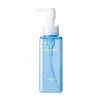HABA Micro Force Cleansing Versus HABA G-Lotion
What's inside
What's inside
 Key Ingredients
Key Ingredients

 Benefits
Benefits

 Concerns
Concerns

 Ingredients Side-by-side
Ingredients Side-by-side

Water
Skin ConditioningButylene Glycol
HumectantSasa Kurilensis Water
Skin ConditioningPentylene Glycol
Skin ConditioningSea Salt
AbrasiveSodium Hyaluronate
HumectantSodium Chondroitin Sulfate
Skin ConditioningAlgae Extract
EmollientDipotassium Glycyrrhizate
HumectantScutellaria Baicalensis Root Extract
AstringentLithospermum Officinale Root Extract
Skin ConditioningHydrolyzed Soy Protein
HumectantSuccinic Acid
BufferingAluminum Chloride
AstringentCitric Acid
BufferingSodium Citrate
BufferingWater, Butylene Glycol, Sasa Kurilensis Water, Pentylene Glycol, Sea Salt, Sodium Hyaluronate, Sodium Chondroitin Sulfate, Algae Extract, Dipotassium Glycyrrhizate, Scutellaria Baicalensis Root Extract, Lithospermum Officinale Root Extract, Hydrolyzed Soy Protein, Succinic Acid, Aluminum Chloride, Citric Acid, Sodium Citrate
Ingredients Explained
These ingredients are found in both products.
Ingredients higher up in an ingredient list are typically present in a larger amount.
Butylene Glycol (or BG) is used within cosmetic products for a few different reasons:
Overall, Butylene Glycol is a safe and well-rounded ingredient that works well with other ingredients.
Though this ingredient works well with most skin types, some people with sensitive skin may experience a reaction such as allergic rashes, closed comedones, or itchiness.
Learn more about Butylene GlycolCitric Acid is an alpha hydroxy acid (AHA) naturally found in citrus fruits like oranges, lemons, and limes.
Like other AHAs, citric acid can exfoliate skin by breaking down the bonds that hold dead skin cells together. This helps reveal smoother and brighter skin underneath.
However, this exfoliating effect only happens at high concentrations (20%) which can be hard to find in cosmetic products.
Due to this, citric acid is usually included in small amounts as a pH adjuster. This helps keep products slightly more acidic and compatible with skin's natural pH.
In skincare formulas, citric acid can:
While it can provide some skin benefits, research shows lactic acid and glycolic acid are generally more effective and less irritating exfoliants.
Most citric acid used in skincare today is made by fermenting sugars (usually from molasses). This synthetic version is identical to the natural citrus form but easier to stabilize and use in formulations.
Read more about some other popular AHA's here:
Learn more about Citric AcidWater. It's the most common cosmetic ingredient of all. You'll usually see it at the top of ingredient lists, meaning that it makes up the largest part of the product.
So why is it so popular? Water most often acts as a solvent - this means that it helps dissolve other ingredients into the formulation.
You'll also recognize water as that liquid we all need to stay alive. If you see this, drink a glass of water. Stay hydrated!
Learn more about Water